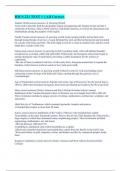HIUS 221 TEST 1 || All Correct.
Atlantic World correct answers (A Growing World)
Term used to describe both the geographic region encompassing the Atlantic Ocean and the 4
continents of Europe, Africa, North America, and South America, as well as the interactions and
relationships among the peoples of this region.
Feudal Vassals correct answers (A growing world) Land-owning nobility tied to their lords
through mutual bonds of service; a vassal defended his lord, and the lord protected and rewarded
his vassals with riches and land. The lord might in turn be a vassal to another lord, and the vassal
might have vassals of his own.
Nation-state correct answers (A growing world) A political entity with well-defined boarders
recognized as sovereign, stable and indivisible. Historically, the European nation-state began to
emerge during the Age of exploration, providing a stable foundation for the actions of
exploration.
-The rise of these (combined with loss of silk road), drove European monarchies to expand the
boarders of their known world in search of new trade and wealth
Silk Road correct answers (A growing world) Collective term for well-used trading routes
connecting western Europe with India and China, running through the gateway city of
Constantinople
Age of Exploration correct answers Popular term (Also Age of Discovery) fro the period from c.
1450 to 1600 when European navigators discovered and charted new lands to the West and East.
Maya correct answers (Native America and West African Societies before Contact)
Inhabitants of the Yucatan Peninsula whose civilization was at its height from 300 to 900 AD.
Their civilization included a unique system of writing, mathematics, architecture, sculpture, and
astronomy.
-Built the city of Trotihuacan, which contained pyramids, temples and palaces
-Extended their empire to more than 50 states
Aztecs correct answers Inhabitants of the Valley of Mexico who founded their capital,
Tenochtitlán, in the early fourteenth century. Prior to the arrival of the Spanish, the Aztecs built a
large empire in which they dominated many neighboring peoples. Their civilization included
engineering, mathematics, art, and music.
-Thrived between 1200 and 1521
-Established a militaristic state with Tenochtitlan as a capital
-effectively controlled territories surrounded their capital from the Pacific to the Gulf Coast
-Were paid tribute in gold, turquoise, cotton, and human sacrifice by conquered peoples under
them
Iroquois Confederacy correct answers (Native America and West African Societies before
Contact)
, Indian group located in central New York State. Five tribes—the Mohawks, Oneidas,
Onondagas, Cayugas, and Senecas—formed the Iroquois Confederacy.
-Inhabited Eastern Woodlands
Matrilineal correct answers (Native America and West African Societies before Contact)
A system in which family membership and heredity pass from mother to children
Songhai correct answers (Native America and West African Societies before Contact)
Dominant West African state in the fifteenth and sixteenth centuries. Askia Mohammed (ruled
1493-1528) expanded the empire; reformed government, banking, and education; and adopted
Islamic law.
-dominated western Africa since before 300 AD
Prince Henry "The Navigator" (1394-1460) correct answers (Technology and European
Exploration)
Henry of Portugal, who established a school for navigators and geographers. He sought to
increase the power of Portugal by promoting exploration of trade routes to the East by way of
Africa.
-In about 1418, Prince Henry "the Navigator" determined to find the sub-Saharan African source
of wealth he saw in North African marketplaces and trade directly.
-Using a light, maneuverable, strong ship called the caravel, as well as new technologies such as
the astrolabe, Henry's fleets sailed farther and farther south along Africa's coast.
Caravel correct answers (Technology and European Exploration)
Type of ship developed around 1450 employing technology that would let it travel farther into
uncharted waters and withstand the rough seas of the open Atlantic
Astrolabe correct answers (Technology and European Exploration)
Navigation instrument for estimating latitude by measuring the distance of the sun and stars from
the horizon.
Christopher Columbus (1451-1506) correct answers (Technology and Early European
Exploration)
Italian mariner who sailed for Spain in 1492 in search of a western route to Asia. He located San
Salvador in the West Indies, opening the Americas to European exploration and colonization.
-Christopher Columbus, a Genoese sailor, spent time in the 1480s on merchant vessels trading
with Portuguese ports in Africa and learned of their quest for the East.
-In 1485, Columbus approached Portugal's King John II with the idea of traveling west to reach
China and India, but he was rejected.
-After many rejections, in 1492 Columbus convinced Spain's King Ferdinand and Queen Isabella
to fund the voyage. Spain, newly unified, needed new trade to refill its coffers.
-Columbus's crews spotted a Caribbean island on October 12, 1492. They made their first
settlement on Hispaniola
Bartolomeu Dias (c. 1451-1500) correct answers (Technology and Early European Exploration)




